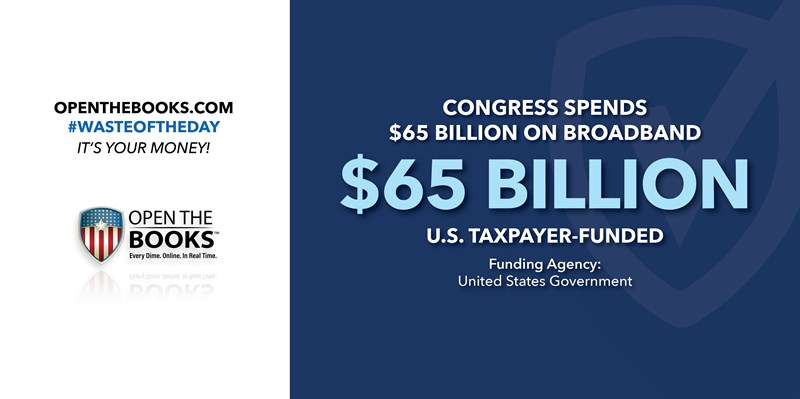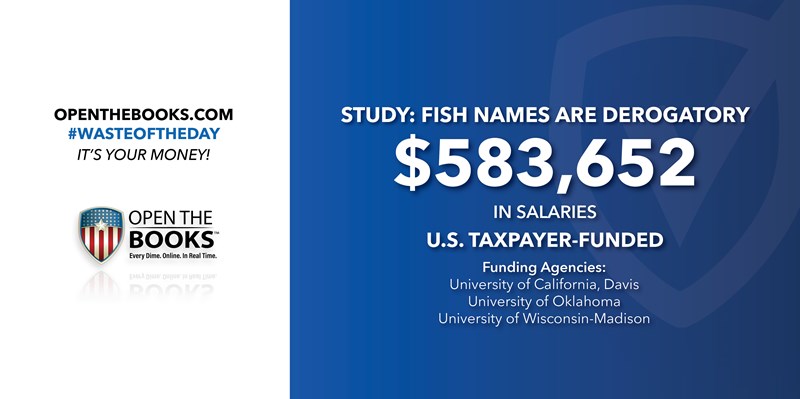
“Bi-Partisan” Infrastructure Bill Allocates $40 Billion for Government-Owned Internet | August 16, 2021

Who wants the government tracking your personal broadband usage or what web pages that you view?
With government-owned internet service, the government will potentially know everything about you and your private business.
Included in the “bi-partisan” infrastructure bill was $65 billion for broadband projects. This included $42.5 billion earmarked for municipal efforts, despite numerous examples of government-owned broadband boondoggles and failures.
While supporters of government-owned networks (GON) will argue that they’re needed because the private sector won’t build them, broadband providers have spent more than $1.6 trillion since 1996 to build and improve networks, a 71% growth in rural broadband, according to Taxpayers Protection Alliance.
In spring 2021, President Joe Biden proposed spending $100 billion on broadband and the administration is serious about the effort. The second-most-highly paidWhite House official is its broadband czar.
In the last 10 years, there have been dozens of GON proposed in municipalities and states across the country, some of which died before they got started, while others were sold at a loss to private companies, according to Reason Magazine.
In Kentucky, a 2015 plan was to build a GON over more than 3,000 miles for an estimated $350 million and be completed by 2016.
An audit four years later found that the stalled project cost taxpayers at least $1.5 billion, thanks to cost overruns, consultant fees, and a crooked bidding process that gave contracts to political connections instead of to people who could do the job quickly and well.
The government networks that remain are nearly obsolete because 5G wireless connections and other private-sector innovations offer competitive speeds and better prices.
So what does government plan to do? Pour $42.5 billion into more of these projects.
Before Congress allows that funding to be passed, it should consider whether the private sector is already serving its customers well and whether government needs to be involved at all.
America Gave Afghanistan $6 Billion in Annual Foreign Aid – Now the Taliban Is Poised to Take Over | August 17, 2021

In 2018, Afghanistan received $6 billion in foreign aid from the United States, the most of any country in the world and twice that of the runner up, Israel, which received $3 billion.
That year, the last year available, the U.S. spent $46.9 billion on foreign aid, according to OpenTheBooks.com’s new oversight report, U.S. Foreign Aid: How and Where the U.S. Spent $282.6 Billion (Fiscal Years 2013-2018).
President Joseph Biden said the U.S. will continue to provide humanitarian and economic assistance to Afghanistan even after the troop withdrawal, which is scheduled to conclude by Aug. 31.
"We did not go to Afghanistan to nation build," Biden said. "It's the right and the responsibility of Afghan people alone to decide their future and how they want to run their country," according to USA Today.
The newspaper notes “the new deadline comes as the Taliban continue to gain new territory at an alarming pace, raising concerns the militant Islamic group could topple the Afghan government.”
Biden said he believes in the ability of the Afghan National and Defense Security Forces to defend against the Taliban. But the Taliban swiftly retook control of Afghanistan this month.
Afghanistan certainly looks like a failed foreign aid project.
Feds to Dole Out $38 Million in Grants to Passenger Ferries | August 18, 2021

Bring on the passenger ferries!
The U.S. Department of Transportation is awarding $38 million in grants for passenger ferries. There were 220 ferry operators as of a 2016 count by the U.S. DOT’s Bureau of Transportation Statistics.
78 were reported to be a public operation on behalf of a federal, state or a local government agency and 142 reported as a private operation.
Of the $38 million doled out in 30 grants, $4 million will be only for low or zero-emission ferries or ferries that use electric battery or fuel cell components.
According to the grant summary, the funds will be used “to support capital projects to improve existing passenger ferry service, establish new ferry service, and repair and modernize ferry boats, terminals, and related facilities and equipment.”
New York City recently added several ferry routes, run by the NYC DOT, and paid for in part with a swipe of a rider’s public transit card — $2.75. The city subsidizes ferry service since it costs far more than that per rider.
The five boroughs that make up the Big Apple are surrounded by water, with tunnels and bridges connecting them. Critics say more investments should be made in its buses and subway instead, since the low-capacity ferry system does little to transport most of the city’s 8.5 million residents.
Perhaps New York City will be among the municipalities grabbing for some of that $38 million.
In 1977, The Question Was: Why Do Inmates Want to Escape from Prison | August 19, 2021

Throwback Thursday!
The number of people incarcerated in state, federal and other detention facilities the U.S. hovers around 2 million — more before the Covid-19 pandemic and fewer once the pandemic was underway.
That number was far lower in 1977 with only 278,141 people incarcerated. Still, Sen. William Proxmire gave one of his well-known awards to the Law Enforcement Assistance Administration that year.
Until it was dissolved in 1988, the LEAA was a part of the U.S. Department of Justice.
In 1977, the LEAA spent nearly $27,000 ($119,938 when adjusted for inflation) to determine why inmates want to escape from prison.
Proxmire, a Democrat from Wisconsin, gave awards to wasteful and nonsensical spending. He handed out 168 Golden Fleece Awards between 1975 and 1988.
A study to consider why someone sitting in a prison cell wants to leave is the height of wasteful spending and deserved Proxmire’s award.
UC Davis Study: Names That White Males Gave Fish Are Racist
| August 20, 2021

This sounds fishy… researchers at University of California, Davis have turned to fish for their racism studies.
Published online in late July, the study argues that calling some fish “rough” or “trash” is a racist term that comes from “white males’” dominance of freshwater fisheries in North America for the past three centuries, according to Campus Reform.
Four of the researchers — two from UC California, Davis, one from University of Oklahoma and one from University of Wisconsin-Madison — are paid, six-figure professors at their respective public universities.
These four professors received $583,652 in collective annual salaries. Here is how it breaks down: UC Davis paid the two professors a combined $311,123 in wages (FY2019). The Oklahoma and Wisconsin professors were paid a collective $272,529 (FY2020). All pay records are publicly posted online at OpenTheBooks.com and are the latest year available.
Over the year-and-a-half this study was done, additional research was done by an unpaid professor emeritus at UC Davis, a UC Davis postdoc researcher, a UC Davis PhD candidate, a researcher from the private University of Notre Dame and researcher with the non-profit Nature Conservancy.
The researchers argue that since white males have valued only select types of fish and dominated the management of freshwater fisheries, the native fish faced discrimination. These native fishes, the study says, historically fed Black and Indigenous people of color and immigrants.
There is a “bias against ‘rough fish’ — a pejorative ascribing low-to-zero value for countless native fishes,” the study states. “One product of this bias is that biologists have ironically worked against conservation of diverse fishes for over a century, and these problems persist today.”
These problems include allowing overfishing of native species, which leads to a decline in their population, the study said.
The #WasteOfTheDay is presented by the forensic auditors at OpenTheBooks.com.